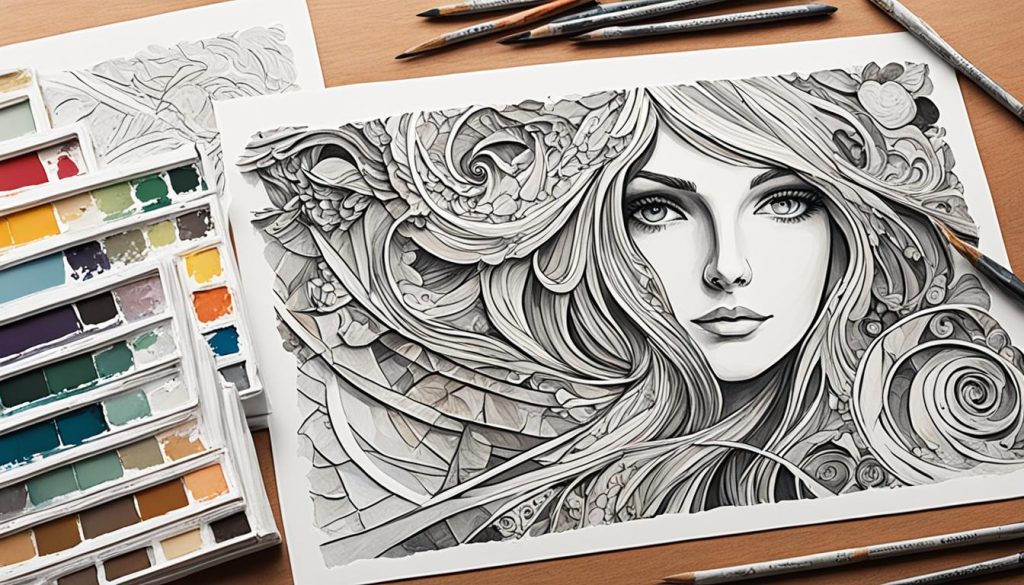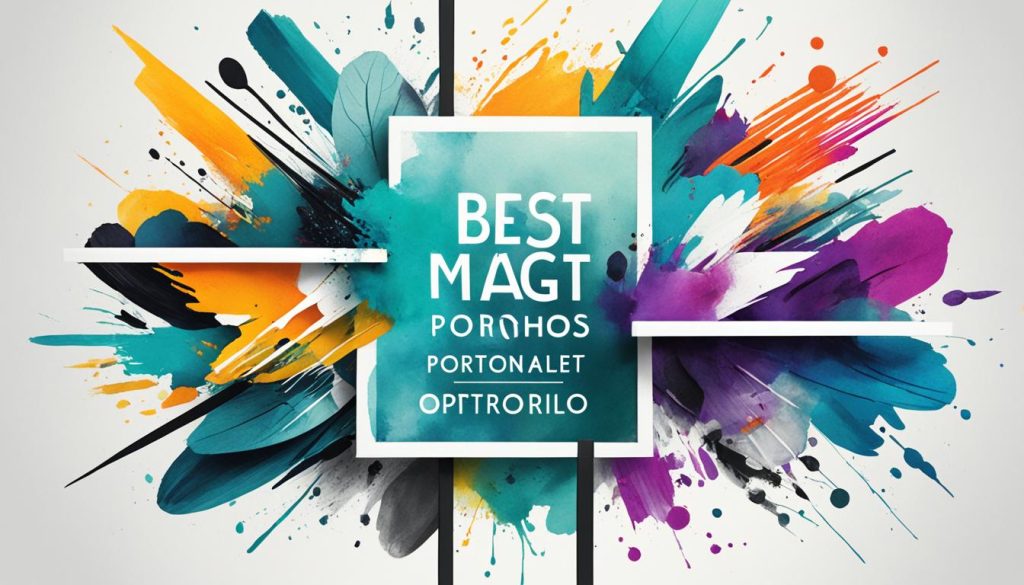As an aspiring artist, creating a visually stunning art portfolio is essential for showcasing your skills and catching the attention of potential employers and clients. Your art portfolio serves as a visual resume, telling your unique artistic story and demonstrating your creativity. In this guide, I will share essential tips and tricks on how to make an art portfolio that captivates and impresses.
Key Takeaways:
- Building a visually stunning art portfolio is crucial for aspiring artists.
- Your art portfolio serves as a visual resume that showcases your skills and creativity.
- Highlight your best works and maintain a sense of conceptual coherence.
- Consider using a professional portfolio platform or creating a dedicated website to showcase your work online.
- Regularly update your portfolio and seek feedback to ensure it remains relevant and engaging.
Why You Need an Art Portfolio
An art portfolio is more than just a collection of your artwork; it’s a narrative that tells your artistic story and introduces you to the world. It serves as a powerful tool to showcase your skills, creativity, and artistic journey. Whether you’re applying for art school or seeking gallery representation, having a well-crafted art portfolio is essential for success in the art industry.
Creating an impressive art portfolio requires careful thought and consideration. Here are some essential tips to help you showcase your artwork effectively:
- Curate your best work: Select a diverse range of your strongest pieces that represent your artistic style and skills.
- Highlight your creative process: Include sketches, studies, and works-in-progress to demonstrate your artistic growth and problem-solving abilities.
- Provide context: Write artist statements and descriptions for each artwork to provide viewers with insights into your inspirations and motivations.
- Consider the format: Choose a portfolio format that suits your needs, such as a physical portfolio, an online portfolio website, or a combination of both.
“An art portfolio is not only a showcase of your talent but also a representation of your dedication and artistic vision. It’s an opportunity to captivate viewers and leave a lasting impression.
When creating an online portfolio, you have the advantage of reaching a broader audience and harnessing the power of digital tools to enhance your presentation. Showcase your artwork online by:
- Choosing a user-friendly platform: Select a platform or website builder that offers customizable templates and easy navigation for a seamless viewing experience.
- Optimizing your images: Ensure your artwork is presented in high-quality images that accurately represent your original pieces.
- Creating a cohesive layout: Arrange your artwork in a visually appealing manner, grouping them by theme, medium, or chronology to create a cohesive narrative.
The Power of an Art Portfolio
An art portfolio serves not only as a showcase for potential clients, galleries, and art institutions but also as a personal journey of artistic growth and self-expression. It has the power to impress, inspire, and open doors to numerous opportunities in the art world. Take the time to craft your art portfolio with care, and let it be a reflection of your unique artistic voice.
Now that you understand the importance of an art portfolio, let’s explore the key elements that make an exceptional art portfolio in the next section.
https://www.youtube.com/watch?v=mkAyc6i85oI
Key Elements of an Exceptional Art Portfolio
An exceptional art portfolio is a powerful tool for artists to showcase their skills and creativity. It goes beyond a mere collection of artwork; it tells a visual story and reflects the artist’s unique style and vision. Here are key elements that can make your art portfolio stand out:
Showcase Your Best Work
Highlight your strongest pieces in your art portfolio. Choose artworks that demonstrate your technical proficiency, creativity, and unique style. Including a variety of mediums and subject matters can showcase your versatility as an artist. Remember, quality is more important than quantity.
Highlight Your Versatility and Range of Skills
Demonstrate your ability to work with different mediums, styles, and subject matters. This allows potential clients and employers to see the breadth of your artistic skills. Showcase your ability to experiment and adapt to various artistic challenges.
Maintain Conceptual Coherence
Create a sense of cohesion and consistency in your art portfolio by aligning your artistic choices with a central theme or concept. This helps viewers understand your artistic vision and the narrative behind your work. Consistency in style, color palette, or subject matter can create a strong visual impact.
Include a Compelling Artist Statement
An artist statement provides insight into your artistic process, motivations, and intentions. It is an opportunity to connect with viewers on a deeper level by sharing the inspiration behind your work. Craft a clear and concise statement that reflects your artistic journey and enhances the understanding and appreciation of your portfolio.
Consider using a professional portfolio platform or creating a dedicated website to showcase your work online. This allows you to present your art portfolio in a visually engaging and easily accessible format.
Remember, an exceptional art portfolio is not just a collection of artwork; it is a representation of your artistic journey, skills, and unique vision. By incorporating these key elements, you can create a visually stunning portfolio that captivates and engages viewers.

Now that you have a better understanding of the key elements of an exceptional art portfolio, it’s time to dive deeper into organizing your portfolio for maximum impact.
Organizing Your Art Portfolio
Organizing your art portfolio is a crucial step in creating a cohesive and engaging experience for viewers. How you arrange and present your artwork can greatly impact how it is perceived and understood. Whether you’re preparing for an art exhibition, applying to art school, or showcasing your work online, a well-organized portfolio can make a significant difference.
When deciding on the best art portfolio format for your work, there are two main approaches to consider: organizing chronologically or thematically.
Organizing Chronologically
One option is to arrange your artwork in chronological order, starting with your earliest pieces and progressing to your most recent work. This format allows viewers to follow your artistic development and witness how your skills and style have evolved over time. By showcasing your growth as an artist, you demonstrate your dedication and commitment to honing your craft.
However, keep in mind that organizing chronologically may not always be the best choice, especially if you have a diverse body of work or if your earlier pieces do not accurately reflect your current artistic abilities. In such cases, a thematic approach might be more suitable.
Organizing Thematically
When organizing your art portfolio thematically, you group together artworks that share a common theme, subject matter, or artistic technique. This format allows viewers to see the depth and breadth of your artistic exploration within specific concepts or styles. It also provides an opportunity to create a narrative or tell a story through your work.
For example, if you have a series of landscape paintings, you could create a section dedicated to showcasing the beauty of nature. Alternatively, if you work with various mediums and styles, you can organize your portfolio by medium or technique, such as a section for acrylic paintings, another for charcoal drawings, and so on.
Regardless of the organizing method you choose, it is essential to use clear labels and headings to guide viewers through your art portfolio. This will help them navigate seamlessly through your works, ensuring a smooth and enjoyable viewing experience.
In addition to organizing your artwork, pay attention to the layout and design of your art portfolio. High-quality images and a visually appealing presentation can greatly enhance the impact of your work. Consider using an online portfolio platform or creating a dedicated website to showcase your art. These platforms offer flexibility in organizing and presenting your work, allowing you to create a visually stunning portfolio that captivates and engages your audience.

Remember, organizing your art portfolio is not a one-time task. As you create new artworks and your artistic style evolves, regularly update your portfolio to reflect your latest work and accomplishments. Seek feedback from trusted peers or mentors to ensure your portfolio effectively communicates your artistic vision and goals.
Now that you have a better understanding of how to organize your art portfolio, it’s time to create a visually stunning showcase of your artistic talents. Let your creativity shine through your portfolio, and enjoy the process of curating a collection that represents who you are as an artist.
Conclusion
Creating an impressive art portfolio requires careful thought and consideration. By following the tips and guidelines mentioned in this guide, you’ll be able to craft a visually stunning portfolio that effectively showcases your unique artistic talents.
Regularly updating your portfolio is essential to ensure that it reflects your growth and latest works. Seek feedback from trusted individuals, such as fellow artists or mentors, to gain valuable insights and improve your portfolio further.
Remember to adapt your portfolio to your specific goals and objectives. Whether you want to apply to art school, seek gallery representation, or attract potential clients online, customizing your portfolio to cater to your target audience is key.
By utilizing professional portfolio platforms or creating your own artist website, you can confidently showcase your artwork online and reach a wider audience. With a well-crafted art portfolio, you’ll be one step closer to achieving success in the art industry.
FAQ
How do I create an impressive art portfolio?
Should I use a professional portfolio platform or create a dedicated website?
How should I organize my art portfolio?
Do I need to regularly update my art portfolio?
How can I seek feedback on my art portfolio?
Share this content:






